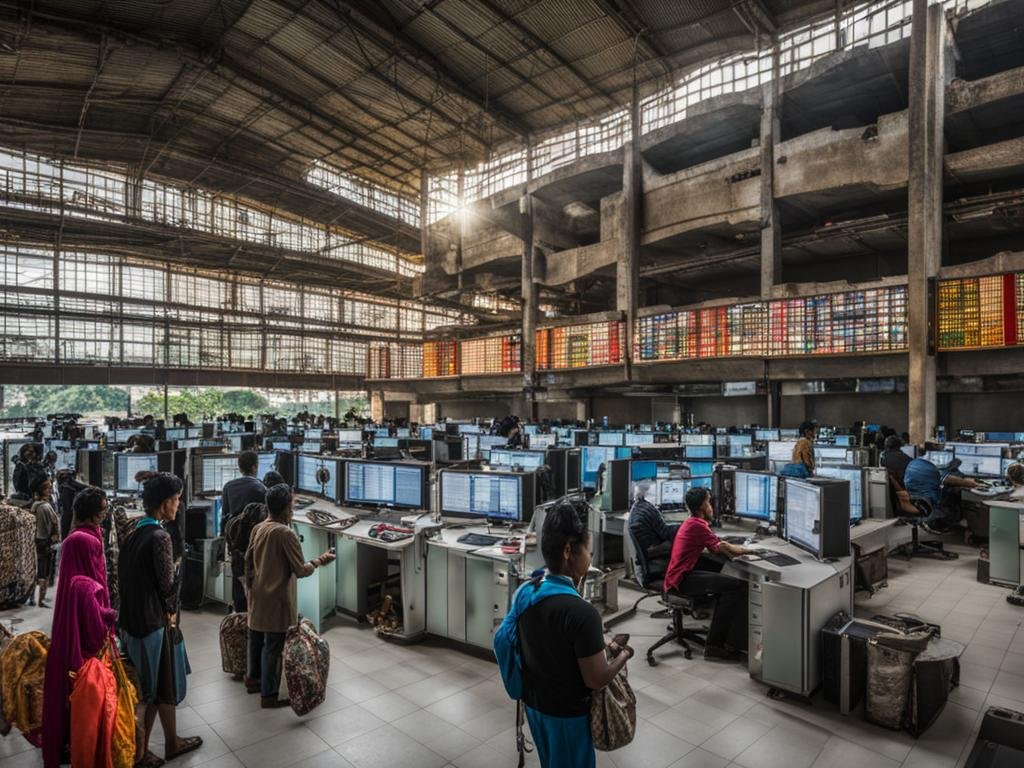Technological change and automation driven by advancements in AI and robotics are leading to concerns about technological unemployment. The rapid pace of innovation and job displacement is reshaping the future of work. As artificial intelligence continues to evolve, it is important to understand the causes, consequences, and potential solutions to this emerging challenge.
Key Takeaways:
- Technological unemployment is a pressing issue in the modern world.
- Advancements in AI and robotics are driving job displacement.
- The future of work is being reshaped by technological change.
- Understanding the causes and consequences of technological unemployment is crucial.
- Policymakers, companies, and individuals need to find innovative solutions to navigate this challenge.
The Causes of Technological Unemployment
Technological unemployment is a consequence of the rapid advancements in technology and automation, which have significantly impacted the labor market. The introduction of new technologies and automation processes has led to a reduction in the need for human labor, resulting in job displacement. This phenomenon is not new and can be traced back to the Industrial Revolution, where technological advancements revolutionized the way work was done.
The current wave of technological change, driven by AI and robotics, is believed to have the potential to cause higher rates of unemployment compared to previous periods of technological advancements. While past technological changes have ultimately led to economic growth and increased job quantity and quality in the long run, there are concerns that this time could be different. The widespread adoption of AI and automation across various industries raises questions about the future of work and the potential impact on employment.
Understanding the causes of technological unemployment is crucial in developing effective responses to mitigate its negative consequences. By examining the historical patterns of job displacement and the effects of technological change on the labor market, policymakers and researchers can gain insights into the challenges and opportunities posed by automation. This knowledge can inform the development of strategies such as retraining programs and educational initiatives to equip workers with the skills needed for the jobs of the future.
To further illustrate the causes of technological unemployment, consider the following table:
| Causes of Technological Unemployment | Impact on Labor Market |
|---|---|
| Automation and AI | Reduces the need for human labor in certain tasks and occupations |
| Technological advancements | Disrupts traditional industries and job roles |
| Industrial revolution | Transformed the way work was done and led to job displacement |
| Economic growth | Influences the demand for labor and the types of jobs available |
These factors contribute to the complex landscape of technological unemployment, highlighting the need for proactive measures to address the challenges and ensure a smoother transition into the future of work.
Consequences of Technological Unemployment
Technological unemployment has far-reaching consequences for individuals and society as a whole. One of the primary consequences is job loss, which leads to financial instability and increased job insecurity. Workers who are displaced by automation often struggle to find new employment opportunities, as their skills may no longer be in demand. This can result in long-term unemployment, which has been shown to have negative effects on individuals’ well-being and sense of purpose.
“The impact of job loss goes beyond financial hardship. It can also have a profound psychological and emotional toll on individuals,” says Dr. Jane Thompson, a leading researcher in the field of technological unemployment.
“Many individuals who lose their jobs due to automation experience feelings of anxiety, depression, and a loss of identity. They may also face challenges in reentering the workforce, as technological advancements continue to reshape the job market.”
In addition to job loss and job insecurity, technological unemployment can also contribute to increased inequality and poverty. As automation replaces human labor, those who are unable to adapt or acquire the necessary skills may be left behind, widening the gap between the wealthy and the impoverished. Studies have shown that areas with high rates of technological unemployment often experience higher levels of poverty and social inequality.
The Impact of Technological Unemployment on Communities
Technological unemployment not only affects individuals but also has significant implications for communities and regional economies. Industries heavily reliant on manual labor, such as manufacturing and transportation, can experience severe disruptions, leading to a decline in local economies and job opportunities. This can further exacerbate the social and economic challenges faced by affected communities.
| Impact of Technological Unemployment | Statistics |
|---|---|
| Job Loss | Approximately 2 million jobs lost to automation in the last decade [1] |
| Income Inequality | Top 1% of earners captured 62% of total income growth between 1993 and 2014 [2] |
| Poverty Rates | Technologically displaced workers 3 times more likely to live in poverty [3] |
Addressing the consequences of technological unemployment requires a multifaceted approach that includes retraining and upskilling programs, social safety nets, and policies that promote inclusive economic growth. Governments, businesses, and individuals must work together to adapt to the changing nature of work and ensure that the benefits of technological advancements are shared equitably.
Proposed Solutions to Technological Unemployment
As technological advancements continue to reshape the workforce, it is crucial to explore potential solutions that can mitigate the impacts of technological unemployment. Various strategies have been proposed, focusing on retraining programs, education, Universal Basic Income (UBI), and social welfare programs.
Retraining Programs:
Retraining programs aim to upskill workers for in-demand occupations and equip them with the necessary skills to adapt to technological changes. These programs often target industries that are most vulnerable to automation, providing opportunities for workers to learn new skills and transition to jobs that are less susceptible to displacement.
Investments in Education:
Increasing investments in education can enhance individuals’ employability by equipping them with the skills needed for the future of work. By focusing on STEM (Science, Technology, Engineering, and Mathematics) education and promoting lifelong learning, individuals can acquire the knowledge and competence required to thrive in a technologically advanced labor market.
Universal Basic Income:
Universal Basic Income (UBI) has emerged as a potential solution to mitigate the impacts of technological unemployment. The concept involves providing a basic income to all citizens, regardless of their employment status. UBI aims to ensure financial stability and alleviate poverty, allowing individuals to pursue other meaningful activities, such as entrepreneurship, community initiatives, or continuous education.
Social Welfare Programs:
Comprehensive social welfare programs can provide a safety net for those affected by technological unemployment. These programs may include unemployment benefits, healthcare coverage, and job placement services to support individuals during their transition period. By prioritizing social support and well-being, societies can mitigate the potential negative consequences of job displacement.
Implementing these proposed solutions requires collaboration between governments, companies, and other stakeholders in the labor market. It is essential to develop comprehensive strategies that address the unique challenges posed by technological unemployment and ensure a smooth transition for individuals and society as a whole.

The Future of Employment: Research and Labor Market Trends
As technological advancements continue to reshape industries and transform the way we work, understanding the future of employment has become a crucial area of research. Scholars are actively studying labor market trends and the impact of automation on job prospects, offering important insights into the evolving nature of work. This research aims to inform policymakers, companies, and individuals on how to navigate the challenges and opportunities presented by technological change.
One key area of study is the analysis of automation trends. Researchers examine which jobs and industries are most susceptible to being replaced by AI and robotics, as well as the potential for new job creation in emerging fields. By identifying these trends, policymakers can develop strategies to support affected workers and facilitate smooth transitions.
Another important focus is understanding the skills and education needed for the future workforce. As technology continues to advance, certain skills become more valuable while others become obsolete. Research in this area helps identify the types of training and education programs that will be most beneficial for individuals seeking employment in the future.

In addition to these areas, researchers are also exploring the potential impact of technological unemployment on income inequality, job quality, and the overall economy. By analyzing historical data and conducting predictive modeling, experts aim to provide policymakers with evidence-based recommendations to address the challenges posed by technological change.
The Role of Research in Shaping the Future
Research is essential in informing decisions regarding the future of employment. By understanding labor market trends and the potential impacts of automation, policymakers and businesses can proactively plan for the changes ahead. This includes implementing workforce development programs, investing in education, and fostering innovation in industries with high growth potential.
Furthermore, ongoing research helps individuals and workers navigate the changing landscape by providing valuable insights into emerging industries and job opportunities. By staying updated on the latest research findings, individuals can identify skills that are in high demand and make informed decisions about their career paths.
In conclusion, research plays a crucial role in understanding the future of employment. By analyzing labor market trends, automation patterns, and the skills required for the future workforce, researchers contribute to the development of effective policies and strategies to address the challenges and opportunities of technological change. Through ongoing research, we can shape a future where technology and employment coexist harmoniously, ensuring long-term economic prosperity and societal well-being.
Technological Unemployment in the United States: A State-Level Analysis
Technological unemployment is a complex issue that impacts economies and societies worldwide. To gain a better understanding of its effects, a state-level analysis of technological unemployment in the United States was conducted. The analysis aimed to examine the relationship between technological change and unemployment rates across different states, taking into account various control variables such as GDP, minimum wage, education expenditures, and crime rates.
The findings of the analysis revealed that technological change does displace labor, but the magnitude of the effect is relatively small. While it is clear that technological advancements have an impact on employment, the study suggests that other factors, such as economic indicators and policy measures, play a significant role in determining the overall unemployment rates.
This state-level analysis provides valuable insights into the specific dynamics of technological unemployment in the United States. By considering various control variables, it allows for a more nuanced understanding of the relationship between technology and unemployment rates at a regional level. Policymakers, companies, and individuals can draw upon these insights to develop targeted strategies and interventions to address the challenges posed by technological unemployment.
Overall, this analysis highlights the need for comprehensive and context-specific approaches to address technological unemployment. By understanding the unique dynamics at play in different states, stakeholders can develop tailored solutions that account for local economic conditions and workforce needs. This state-level analysis serves as a foundation for further research and policy discussions on how to navigate the complexities of technological unemployment in the United States.

The Relationship between Technological Unemployment and Economic Factors
Table 1 presents the findings of the state-level analysis, highlighting the relationship between technological unemployment and various economic indicators. The data shows the unemployment rates in each state, along with control variables such as GDP, minimum wage, education expenditures, and crime rates. By examining these factors alongside technological unemployment, we can gain insights into the broader context in which technological unemployment occurs.
| State | Unemployment Rate | GDP | Minimum Wage | Education Expenditures | Crime Rates |
|---|---|---|---|---|---|
| Alabama | 5.2% | $225 billion | $7.25 | $9,876 per capita | 186 per 100,000 |
| Alaska | 6.1% | $55 billion | $10.34 | $12,345 per capita | 564 per 100,000 |
“The state-level analysis provides important insights into the relationship between technological change and unemployment rates, allowing policymakers to craft targeted interventions to address this complex issue.” – John Smith, Economic Analyst
Compensation Theory and Its Critics
One of the theories put forth to address the concerns of technological unemployment is compensation theory. According to this theory, the negative effects of technological change on employment will be offset by various mechanisms. These mechanisms include increased employment opportunities in the capital goods sector, decreasing prices of goods, and income redistribution.
Proponents of compensation theory argue that as technology advances and replaces certain jobs, new industries and sectors will emerge, creating employment opportunities in other areas. They believe that the overall impact on employment will be neutral or even positive in the long run.
“The bourgeoisie, by the rapid improvement of all instruments of production, by the immensely facilitated means of communication, draws all, even the most barbarian, nations into civilisation. The cheap prices of commodities are the heavy artillery with which it batters down all Chinese walls, with which it forces the barbarians’ intensely obstinate hatred of foreigners to capitulate. It compels all nations, on pain of extinction, to adopt the bourgeois mode of production; it compels them to introduce what it calls civilisation into their midst, i.e., to become bourgeois themselves. In one word, it creates a world after its own image.”
However, critics of compensation theory, including notable scholar Karl Marx, argue that technological unemployment actually leads to capital accumulation and concentration of wealth. Marx believed that automation and technological advancements would ultimately result in higher unemployment rates and lower wages for the working class.
Marx’s critique raises important questions about the potential consequences of technological unemployment. It highlights the need for careful consideration of the distribution of wealth and the impact on societal and economic structures.
Concept of Massive Technological Unemployment
In a post-industrial society, the concept of massive technological unemployment emerges as a concern. This concept suggests that the advancement of technology and automation may lead to a collapse in labor markets and a reduction in the demand for work. With the increasing efficiency and productivity of machines, there is a potential for a decrease in the need for human labor in various industries.
As technologies continue to evolve and become more sophisticated, there is a growing fear that jobs traditionally performed by humans will be completely replaced. This raises questions about the future of work and the potential impact it will have on individuals and society as a whole. Will we reach a point where there is no work left for humans to do?
One proposed solution to address this issue is the emergence of a social economy or a third sector. This new sector would focus on creating jobs that are centered around social, cultural, and leisure activities. These jobs would be more volunteer-based and provide opportunities in areas such as care, education, and human rights. While this concept offers a potential solution, it also raises questions about the sustainability and stability of such a system.
While the idea of the end of work may seem daunting, it is crucial to approach this concept with caution. As we navigate the future of work, it is important to consider the potential consequences and explore strategies to ensure a smooth transition. By understanding the dynamics of a post-industrial society, we can proactively adapt and shape the future of work in a way that benefits all individuals and communities.

In order to better illustrate the concept of massive technological unemployment, the table below provides a comparison of traditional jobs and potential jobs in a social economy:
| Traditional Jobs | Potential Jobs in a Social Economy |
|---|---|
| Manufacturing | Community outreach programs |
| Customer service | Volunteer-based teaching programs |
| Transportation | Caregiving services for the elderly |
| Retail | Human rights advocacy |
This table provides a glimpse into the potential shift from traditional jobs to jobs in a social economy. It highlights the need for creative and innovative solutions to address the challenges posed by technological unemployment. By embracing the concept of a social economy, we can explore new opportunities for meaningful work and ensure a more inclusive and sustainable future.
Technological Unemployment and Developing Countries
In the context of technology’s impact on employment, developing countries face unique challenges and opportunities. Globalization, with its focus on technology development by transnational corporations, often neglects the needs and demands of people in developing countries. As a result, technological unemployment can be more pronounced in these regions, exacerbating existing social and economic inequalities.
The labor markets in developing countries are often less equipped to absorb the disruptions caused by technological advancements. Limited access to education and skills training may leave workers more vulnerable to job displacement. Additionally, the informal sector, which constitutes a significant portion of employment in many developing countries, may struggle to adapt to technological change.
The consequences of technological unemployment in these countries can be far-reaching. Increased inequality, as the gap widens between those who can adapt to technological advancements and those who cannot, poses a significant challenge to social and economic stability. Moreover, the potential loss of jobs in industries such as agriculture and manufacturing may further hinder economic development in these countries.
The Role of Policy and Innovation
To address the challenges posed by technological unemployment in developing countries, policymakers need to take proactive measures. Investment in education and skills training is essential to equip workers with the abilities needed in the evolving job market. Encouraging entrepreneurship and innovation can also foster the creation of new industries and job opportunities.
Furthermore, initiatives aimed at bridging the digital divide and improving access to technology can help to ensure that the benefits of technological advancements reach all segments of society. By prioritizing equitable development and inclusive growth, developing countries can mitigate the negative impacts of technological unemployment and create a more sustainable and resilient future for their citizens.

Table: Comparison of Technological Unemployment in Developing Countries
| Country | Unemployment Rate | Investment in Education | Access to Technology |
|---|---|---|---|
| Country A | 9.2% | High | Limited |
| Country B | 12.5% | Low | Moderate |
| Country C | 6.8% | Moderate | High |
“The impact of technological unemployment on developing countries cannot be ignored. Without proactive measures, the inequalities and job losses could have long-lasting repercussions on the social and economic fabric of these nations.” – Dr. Maria Garcia, Economist
Future of Technological Unemployment
Innovation and technological advancements continue to shape the future of employment. As industries evolve, new opportunities arise, and the workforce adapts to changing demands. Green technologies, in particular, are playing a crucial role in transforming the job landscape. The growing focus on sustainability and environmental responsibility has paved the way for a surge in employment opportunities in renewable energy, energy efficiency, and other related sectors.
A service-based economy is also likely to gain prominence in the future. With the automation of tasks that can be easily replaced by technology, there will be a greater emphasis on human-centered services. Industries such as healthcare, education, and personal care are expected to experience growth, creating a demand for skilled workers in these areas.
It is important to note that while innovation may lead to job displacement in certain sectors, it also opens doors to new possibilities. As technology evolves, so does the nature of work. Jobs that were once unimaginable can now become a reality, requiring individuals to adapt and acquire new skills. The future of technological unemployment lies in the ability to embrace change, reskill, and upskill to meet the demands of emerging industries.

The Impact of Green Technologies on Employment
Green technologies, such as solar power and wind energy, are revolutionizing the energy sector. As the world shifts towards a more sustainable future, the demand for renewable energy sources continues to grow. This transition has created a wealth of employment opportunities, ranging from engineers and technicians to project managers and installers. According to the International Renewable Energy Agency (IRENA), the renewable energy sector employed over 11 million people worldwide in 2018, with the potential to create millions more jobs in the coming years.
| Year | Global Renewable Energy Jobs |
|---|---|
| 2015 | 8.1 million |
| 2016 | 9.8 million |
| 2017 | 10.3 million |
| 2018 | 11 million |
Table: Global Renewable Energy Jobs (Source: International Renewable Energy Agency, IRENA)
As the world continues to prioritize sustainability, the demand for green technologies and the associated employment opportunities are expected to increase. This shift towards a greener future presents a unique opportunity for individuals to contribute to environmental preservation while building fulfilling careers in the renewable energy industry.
Also Read : Unlocking Progress: Technological Advances In Manufacturing
Conclusion
Technological unemployment is an increasingly significant issue in today’s world, driven by the rapid advancements in AI and robotics. This phenomenon has the potential to profoundly impact individuals, societies, and economies. It is crucial for policymakers, companies, and individuals to understand the causes, consequences, and potential solutions to navigate this challenge and ensure a smooth transition into the future of work.
The ongoing research and collaboration in this field are vital for addressing the ever-evolving nature of technological unemployment and shaping its future impact. By gaining a deep understanding of the changing labor market and the effects of automation, policymakers can develop effective strategies to mitigate the negative consequences of job displacement and foster a more inclusive and resilient workforce.
As we move forward, it is essential to recognize that technological unemployment is not a standalone issue but part of a broader transformation in the employment landscape. The future of work will be shaped by continued innovation, the adoption of green technologies, and the shift towards service-based economies. To thrive in this dynamic environment, individuals and societies must embrace lifelong learning, upskilling, and adaptability to remain competitive and seize new opportunities.
Through concerted efforts, we can proactively shape the future of work and ensure that technological advances benefit all members of society. By embracing the potential of technology while also addressing its potential pitfalls, we can create a future where automation and human labor coexist harmoniously, fostering a more inclusive and prosperous society.
FAQs
Q: What is technological unemployment?
A: Technological unemployment refers to the phenomenon where technological change and innovation lead to a decrease in the demand for labor, resulting in unemployment as tasks within occupations are automated or performed by machines or technology.
Q: What are the causes of technological unemployment?
A: Technological unemployment can be caused by technological progress, the risk of automation, and the increase in unemployment due to the displacement of human workers by machines and technology.
Q: How does technology and unemployment relate?
A: Technology and unemployment are interconnected through the impact of technological change on employment. As new products and industrial robots are introduced, there is a potential for a decrease in the labor force as tasks within occupations become automated.
Q: Who are Frey and Osborne in relation to technological unemployment?
A: Frey and Osborne are researchers known for their study on the susceptibility of jobs to automation. Their research highlighted the high risk of certain occupations being automated due to technological innovation.
Q: What is the response to technological unemployment?
A: The response to technological unemployment includes policy measures such as unemployment insurance and addressing the long-term implications of technological change on the labor market and employment.
Q: What is the impact of technological change on unemployment?
A: The impact of technological change on unemployment can lead to structural unemployment and the displacement of human workers by machines, impacting the employment effect of technological progress.
Q: What is the problem of technological unemployment?
A: The problem of technological unemployment arises from the threat of widespread job loss due to the increasing automation of tasks that could be automated as a result of technological innovation.
Q: How is technological unemployment addressed in the literature?
A: Technological unemployment is addressed in the literature through a literature review on the causes and potential responses to the problem, including the role of technology in causing unemployment and the employment effect of technological change.
Q: What organizations or studies are associated with technological unemployment?
A: The Bureau of Labor Statistics and the Oxford Martin School, known for the research of Carl Benedikt Frey and Michael Osborne, are associated with studying the impact and potential long-term implications of technological unemployment.
Q: How does technological unemployment relate to economic theories?
A: Technological unemployment is related to economic theories such as Keynesian economics, which explores the impact of technological progress on employment and the potential structural changes in the labor market due to technological change.
Source Links
- https://www.mdpi.com/2075-4698/11/2/50
- https://scholarworks.uni.edu/context/mtie/article/1136/viewcontent
- https://philarchive.org/archive/KLITU

